|
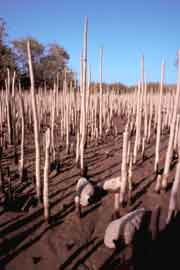 By Rob Baldwin By Rob Baldwin
The largest areas of mangrove in the Gulf area occur along the coast of Iran, with an estimated 9000 hectares (ha) of mangrove. It is estimated that a further 3500-4000 ha remains along the Arabian Gulf coasts of Saudi Arabia, Bahrain and UAE. This figure is declining all the time, as rapid development threatens increasingly isolated mangroves stands. Along the Oman coast, just over 1000 ha of mangrove remain, including the Khor Kalba stand, which straddles the Oman/UAE border. There are few remaining mangrove stands on the Yemen coast of the Arabian Sea and the entire eastern shoreline of the Arabian region therefore hosts very restricted mangrove habitats.
The small mangrove stand at Khor Liwa is situated on the Batinah coast of Oman, approximately 45 kilometres southeast of the large Khor Kalba mangrove forest on the UAE border. Only one other mangrove community exists between these two, namely that at Khor Shinass. Further south, mangrove is generally absent for nearly 200 kilometres, with only a few very small stands still present until the sandy stretch of the Batinah shoreline ends at the large Qurm mangrove near Muscat.
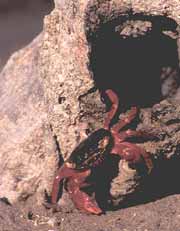 Fiddler crabs Fiddler crabs
A familiar feature of the mangrove stands of Arabia at low tide is the sea of waving white claws of the fiddler crabs (Uca sp.). At Khor Liwa these are particularly abundant and in places Uca burrows seem impossibly dense, reaching nearly two hundred in a single square metre. The crabs themselves are conspicuous as they scuttle over the grey, pock-marked mud on the margins of the mangrove. Holding one oversized white claw above them, which normally takes on the role of a semaphore flag, they make for their burrows and disappear completely from view on the approach of would-be predators. The claw then acts like a trapdoor to the burrow, from behind which the crab will cautiously re-emerge once danger is judged to have passed by.
Ghost crabs
The ghost crab (Ocypode sp.) found at Khor Liwa has a stridulating device on one claw. In a similar fashion to the way grasshoppers and crickets ‘sing’, this crab rubs one claw over a serrated strip on the other claw, effectively ‘playing a fiddle’. This produces quite a loud, characteristic call, thought to be associated with mating.
Mud snails
Shells of the mud snail Terebralia palustris in Khor Liwa are often 8-10 cm long and, being dark in colour, stand out against the light coloured sand and pale green shallows at the edge of mangrove creeks.
A vital nursery for fish and crustaceans
Thirty fish species (from 21 genera and 16 families) can be found hidden in the creeks of Khor Liwa, with approximately 85% of these migrants from the sea, while the remainder are known as mangrove and estuarine residents. Most fish found there are juveniles (the mangroves create nursery grounds) but at least 25 species are considered commercial or food fishes, making these the dominant fishes of Khor Liwa. Add to these over half a dozen species of edible shrimps and crabs, and the mangroves appear to be taking on the role of a cold-store providing significant stock for local, near and offshore fisheries.
A Forest of Trees
Binding the sediment through which the creeks curve and snake their way to the sea and storing the carbon that holds the key to the mangrove’s astounding productivity, are the mangrove trees themselves. Mostly stunted by the harsh environmental conditions and relatively shallow soft-substrate, mangrove trees rarely exceed 8 metres in height at Khor Liwa, or indeed anywhere in Arabia. The same conditions apparently limit not only height but overall growth, as measurements of trunk diameter and analysis of annual growth rings at Khor Liwa suggest an increase of just 2mm per year. Despite this, some of the trees have survived for over century and some individuals may be as old as 150 years.
Studies at Khor Liwa have revealed that approximately 75% of mature trees have been cut by people, who use them for a variety of purposes, including for fire wood, for livestock fodder and even as fish aggregating devices when sunk in offshore waters.
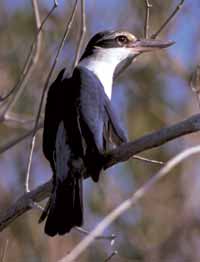 Jewel in the Crown Jewel in the Crown
Khor Liwa and its surrounding salt tolerant shrub land supports over 20 resident breeding bird species together with at least 40 or visiting species. By far the most important and significant of the birds recorded, and arguably the jewel in the mangrove’s crown, is the white-collared kingfisher (Halcyon chloris). Represented at Khor Liwa by the subspecies kalbaensis (after its type and only other locality) Khor Kalba, the white-collared kingfisher is one of the world’s rarest birds. The discovery of this species breeding at Khor Liwa suggests that some young, at least, have dispersed to establish new breeding grounds, although it remains an enigma as to why the mangrove at Khor Shinass, situated between the above two stands has attracted no breeding pairs to date.
KHOR KALBA - CAN IT SURVIVE?
by Colin Richardson
Khor Kalba has a unique ecosystem. For the diverse variety of wildlife that inhabits the mangroves and mudflats of this ancient khor there is simply nowhere else to go. Its importance as a feeding and breeding ground for dozens of species of crab, marine reptiles and birds cannot be over-emphasised. An important combination of features has contributed towards the creek's uniqueness and the removal of any one of these could cause a collapse of the whole system.
The largest resident kingfisher in Arabia, the endemic kalbaensis sub-species of white-collared kingfisher, feeds almost entirely on small crabs. The Kalba population (in effect the world population) of this very handsome bird is at best 55 pairs (Aspinall 1996), making it one of the rarest, and presumably under current circumstances, the most threatened bird on earth. Its breeding success is limited by the number of crusty old mangrove trees available, which provide nest holes, and its need for an abundance of crabs to eat and feed to their young. It is exclusively sedentary; no other suitable habitat is available, except for some isolated remnants of younger mangrove at Shn'aas and Liwa on the Batinah coast of Oman.
Another species of bird, the much smaller, but almost as important, Sykes's warbler, also nests in the Khor Kalba mangroves. Here, virtually the whole Arabian population can be found, numbering no more than about 20 pairs (Aspinall 1996). Little is known about the species - it is so small and secretive - and long-term studies into its biology are long overdue. It would be a pity to lose a species before even its nesting and feeding habits are fully understood.
The khor regularly hosts sea turtles with five species possibly occurring here:– green, hawksbill and leatherback turtles and possibly olive ridley and loggerhead. These enter the creek from the sea at high tide to feed on sea grasses and algae in the khor.
Can Khor Kalba's wildlife survive?
Human threats are inevitably increasing as economic pressure on this wonderful place mounts. Property development and commercial fishing are two factors that need to be reconsidered in the light of the area's biological importance. The adjacent salt flats, though not immediately recognisable as part of the khor's ecosystem, are important as a roost site for gulls, shorebirds and migrant raptors during high tide and should be retained as a 'buffer zone' for the mangrove-dwelling species. With building development and human activity coming so close to a naturally wild area, a threat to the security and safety of the birds is mounting.
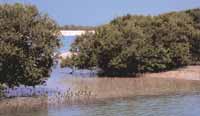 Meanwhile on Khor Kalba beach, just 200 metres across a narrow flora-rich sandbar, whitebait fishing continues unabated. Using rusted old 4WD vehicles, the expatriate fishermen, usually without a UAE patron on hand, tow their nets over the fragile vegetation; their spinning wheels destroying all plants and micro-fauna in their path. As longer and longer nets are employed vehicles are encroaching on the mudflats of the khor itself in order to heave up their heavy nylon loads. With inadequate legal protection or control over the area the damage has already been rapid and possibly irreversible. Despite expressions of concern to local authorities in 2000, by the spring of 2001, few living plants remained on the 300 hectare area of beach-head at Khor Kalba, an area formerly rich in plant diversity where the plants and insects had attracted dozens of species of migrant and breeding birds. At the time of writing this habitat destruction continues and there is little evidence that it will be stopped. Meanwhile on Khor Kalba beach, just 200 metres across a narrow flora-rich sandbar, whitebait fishing continues unabated. Using rusted old 4WD vehicles, the expatriate fishermen, usually without a UAE patron on hand, tow their nets over the fragile vegetation; their spinning wheels destroying all plants and micro-fauna in their path. As longer and longer nets are employed vehicles are encroaching on the mudflats of the khor itself in order to heave up their heavy nylon loads. With inadequate legal protection or control over the area the damage has already been rapid and possibly irreversible. Despite expressions of concern to local authorities in 2000, by the spring of 2001, few living plants remained on the 300 hectare area of beach-head at Khor Kalba, an area formerly rich in plant diversity where the plants and insects had attracted dozens of species of migrant and breeding birds. At the time of writing this habitat destruction continues and there is little evidence that it will be stopped.
Given these extreme pressures on the natural habitat of this once rich ecosystem, it is doubly regrettable that hunting is also taking its toll. The beachhead at Khor Kalba was one of the last strongholds of chestnut-bellied sandgrouse on the UAE East Coast. They used to feed, and probably nested, on the sand bar at Khor Kalba, but shooting seems to have ended that. A visiting bird-watching group in spring 2001, observed a lone hunter shooting and killing a sandgrouse. It was held up as a trophy to his group, displaying a complete lack of understanding about the status of this protected area.
Since many of these activities appear to be contrary to a directive given by the HH Dr Sheikh Sultan bin Mohammed Al Qasimi, Ruler of Sharjah in 1997, it is still hoped that strong action may be taken to protect the area.
All material on this page is copyrighted by Trident Press Ltd and/or individual contributors.
Unauthorised use of photographs or text is strictly prohibited.
|
|



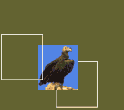
 By Rob Baldwin
By Rob Baldwin Fiddler crabs
Fiddler crabs Jewel in the Crown
Jewel in the Crown Meanwhile on Khor Kalba beach, just 200 metres across a narrow flora-rich sandbar, whitebait fishing continues unabated. Using rusted old 4WD vehicles, the expatriate fishermen, usually without a UAE patron on hand, tow their nets over the fragile vegetation; their spinning wheels destroying all plants and micro-fauna in their path. As longer and longer nets are employed vehicles are encroaching on the mudflats of the khor itself in order to heave up their heavy nylon loads. With inadequate legal protection or control over the area the damage has already been rapid and possibly irreversible. Despite expressions of concern to local authorities in 2000, by the spring of 2001, few living plants remained on the 300 hectare area of beach-head at Khor Kalba, an area formerly rich in plant diversity where the plants and insects had attracted dozens of species of migrant and breeding birds. At the time of writing this habitat destruction continues and there is little evidence that it will be stopped.
Meanwhile on Khor Kalba beach, just 200 metres across a narrow flora-rich sandbar, whitebait fishing continues unabated. Using rusted old 4WD vehicles, the expatriate fishermen, usually without a UAE patron on hand, tow their nets over the fragile vegetation; their spinning wheels destroying all plants and micro-fauna in their path. As longer and longer nets are employed vehicles are encroaching on the mudflats of the khor itself in order to heave up their heavy nylon loads. With inadequate legal protection or control over the area the damage has already been rapid and possibly irreversible. Despite expressions of concern to local authorities in 2000, by the spring of 2001, few living plants remained on the 300 hectare area of beach-head at Khor Kalba, an area formerly rich in plant diversity where the plants and insects had attracted dozens of species of migrant and breeding birds. At the time of writing this habitat destruction continues and there is little evidence that it will be stopped.